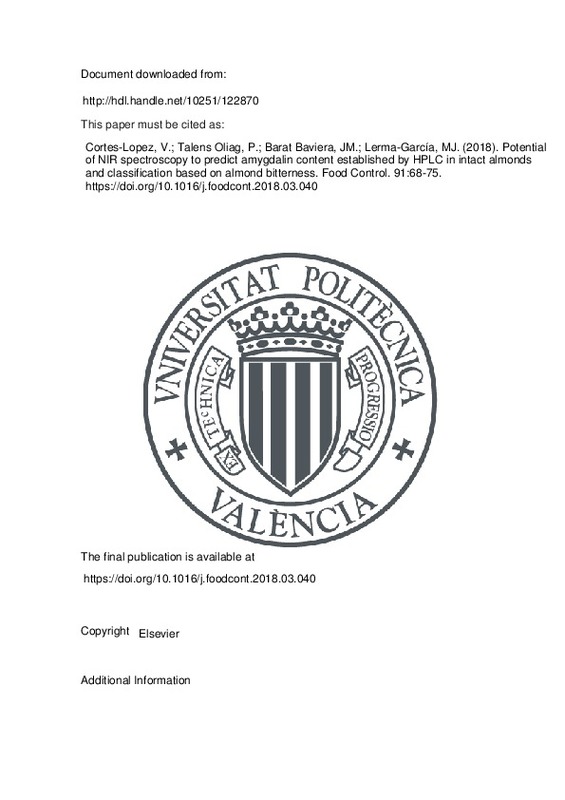JavaScript is disabled for your browser. Some features of this site may not work without it.
Buscar en RiuNet
Listar
Mi cuenta
Estadísticas
Ayuda RiuNet
Admin. UPV
Potential of NIR spectroscopy to predict amygdalin content established by HPLC in intact almonds and classification based on almond bitterness
Mostrar el registro sencillo del ítem
Ficheros en el ítem
| dc.contributor.author | Cortes-Lopez, Victoria
|
es_ES |
| dc.contributor.author | Talens Oliag, Pau
|
es_ES |
| dc.contributor.author | Barat Baviera, José Manuel
|
es_ES |
| dc.contributor.author | Lerma-García, María Jesús
|
es_ES |
| dc.date.accessioned | 2019-06-28T20:03:50Z | |
| dc.date.available | 2019-06-28T20:03:50Z | |
| dc.date.issued | 2018 | es_ES |
| dc.identifier.issn | 0956-7135 | es_ES |
| dc.identifier.uri | http://hdl.handle.net/10251/122870 | |
| dc.description.abstract | [EN] In this study, 360 intact almonds, half sweet and half bitter, were assessed by near-infrared (NIR) spectroscopy to predict amygdalin content (established by high performance liquid chromatography (HPLC)) and by applying partial least squares (PLS) to the spectral data. After optimising amygdalin extraction and chromatographic conditions, the amygdalin contents found by HPLC were not detected or below to 350 mg kg-1 for sweet almonds, and between 14,700 and 50,400mg kg 1 for bitter almonds. The intact almond spectra resulted in good predictions of amygdalin content with R2p of 0.939 and RMSEP of 0.373. Almonds were correctly classified into sweet and bitter by linear discriminant analysis (LDA), quadratic discriminant analysis (QDA) and PLS-DA, with sensitivity and specificity values higher than 0.94 for evaluation set samples. Based on these results, it can be concluded that NIR spectroscopy is a good non-destructive alternative to be used as an automatic in-line classification system by food industry. | es_ES |
| dc.description.sponsorship | Victoria Cortes Lopez thanks the Spanish Ministry of Education, Culture and Sports for the FPU grant (FPU13/04202). The authors wish to thank the cooperative Agricoop for kindly donating the almonds. | es_ES |
| dc.language | Inglés | es_ES |
| dc.publisher | Elsevier | es_ES |
| dc.relation.ispartof | Food Control | es_ES |
| dc.rights | Reserva de todos los derechos | es_ES |
| dc.subject | HPLC | es_ES |
| dc.subject | NIR spectroscopy | es_ES |
| dc.subject | Amygdalin content prediction | es_ES |
| dc.subject | Classification | es_ES |
| dc.subject | Bitter and sweet almonds | es_ES |
| dc.subject | Quality control | es_ES |
| dc.subject.classification | TECNOLOGIA DE ALIMENTOS | es_ES |
| dc.title | Potential of NIR spectroscopy to predict amygdalin content established by HPLC in intact almonds and classification based on almond bitterness | es_ES |
| dc.type | Artículo | es_ES |
| dc.identifier.doi | 10.1016/j.foodcont.2018.03.040 | es_ES |
| dc.relation.projectID | info:eu-repo/grantAgreement/MECD//FPU13%2F04202/ES/FPU13%2F04202/ | es_ES |
| dc.rights.accessRights | Abierto | es_ES |
| dc.date.embargoEndDate | 2019-09-30 | es_ES |
| dc.contributor.affiliation | Universitat Politècnica de València. Departamento de Tecnología de Alimentos - Departament de Tecnologia d'Aliments | es_ES |
| dc.description.bibliographicCitation | Cortes-Lopez, V.; Talens Oliag, P.; Barat Baviera, JM.; Lerma-García, MJ. (2018). Potential of NIR spectroscopy to predict amygdalin content established by HPLC in intact almonds and classification based on almond bitterness. Food Control. 91:68-75. https://doi.org/10.1016/j.foodcont.2018.03.040 | es_ES |
| dc.description.accrualMethod | S | es_ES |
| dc.relation.publisherversion | https://doi.org/10.1016/j.foodcont.2018.03.040 | es_ES |
| dc.description.upvformatpinicio | 68 | es_ES |
| dc.description.upvformatpfin | 75 | es_ES |
| dc.type.version | info:eu-repo/semantics/publishedVersion | es_ES |
| dc.description.volume | 91 | es_ES |
| dc.relation.pasarela | S\359316 | es_ES |
| dc.contributor.funder | Ministerio de Educación, Cultura y Deporte | es_ES |







![[Cerrado]](/themes/UPV/images/candado.png)

